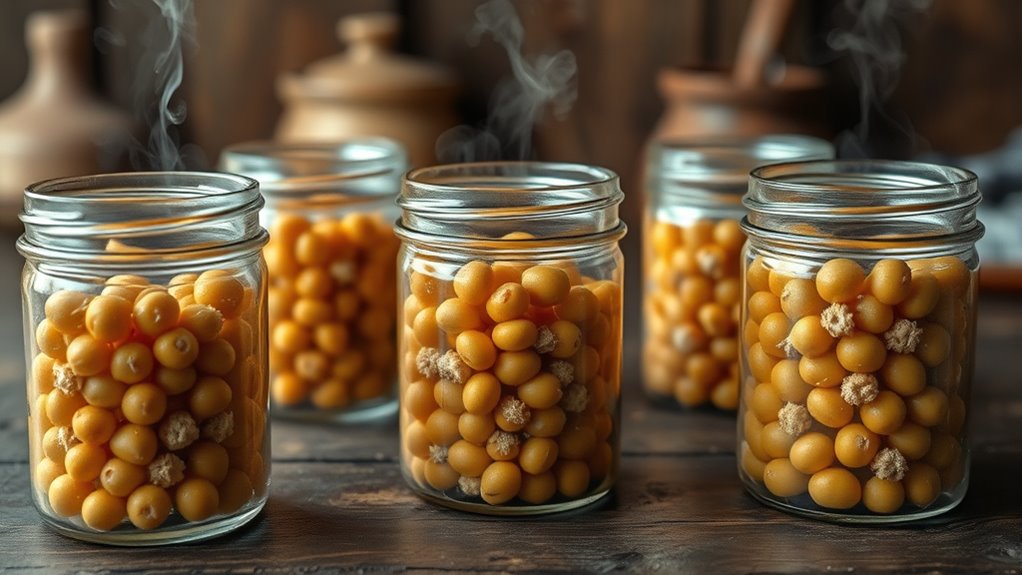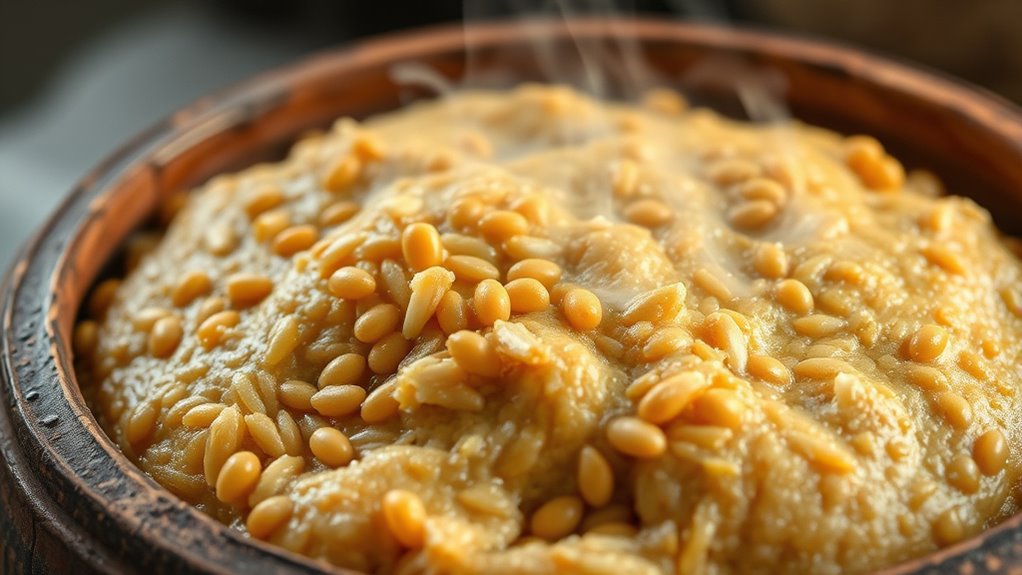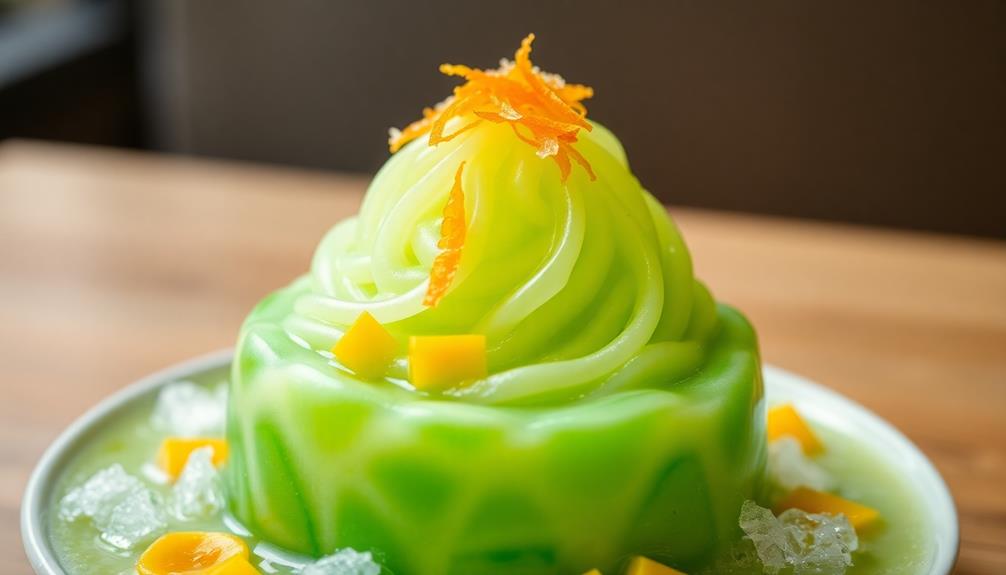To unlock Indonesian tempeh’s umami, you should carefully control fermentation conditions like temperature, humidity, and timing. Maintaining a consistent temperature of around 30°C (86°F) encourages mold growth and enzyme activity, which breaks down proteins into savory amino acids like glutamate. Extending fermentation time boosts flavor complexity, while proper environmental management prevents spoilage. Mastering these adjustments can elevate tempeh’s depth of umami—continue exploring to discover how these techniques unlock its full potential.
Key Takeaways
- Maintain consistent fermentation temperature (~30°C/86°F) to promote mold growth and enzyme activity for umami development.
- Extend fermentation duration (24-48 hours) to enhance amino acid release and deepen savory flavors.
- Control humidity and environmental conditions to optimize mold activity and prevent contamination.
- Adjust moisture, salt, and natural flavor enhancers to influence flavor complexity and richness.
- Use precise, hygienic fermentation practices to ensure safety and achieve consistent umami-rich results.

Many food enthusiasts are discovering that Indonesian tempeh offers a rich, savory umami flavor that elevates any dish. This flavor profile isn’t accidental; it results from specific fermentation techniques that reveal and intensify its natural taste. When you understand and control these fermentation processes, you can considerably enhance the flavor and texture of your tempeh, making it a more versatile and delicious ingredient in your kitchen.
Discover how mastering fermentation techniques unlocks Indonesian tempeh’s rich umami flavor and enhances its versatility in your cooking.
Fermentation techniques are at the core of revealing tempeh’s umami. Traditional methods involve inoculating cooked soybeans with a starter culture containing Rhizopus mold spores. This mold breaks down proteins and complex carbohydrates, transforming the beans into a dense, cohesive cake. By carefully managing factors like temperature, humidity, and fermentation time, you can influence the development of flavor compounds. For instance, maintaining a consistent temperature around 30°C (86°F) encourages ideal mold growth and enzyme activity, resulting in a more robust umami profile.
Flavor enhancement through controlled fermentation isn’t just about speeding up the process; it’s about nurturing the right conditions so that the mold can do its work effectively. Longer fermentation periods, often 24 to 48 hours, allow more extensive breakdown of proteins into amino acids like glutamate, which is responsible for umami. During this time, you might notice a deeper, more complex taste emerging. You can also experiment with slight variations in moisture levels or adding small amounts of salt or other natural flavor enhancers to influence the final taste. Additionally, monitoring environmental conditions**** plays a crucial role in ensuring optimal flavor development.
The key to revealing Indonesian tempeh’s umami lies in your attention to detail during fermentation. By monitoring environmental conditions and adjusting as needed, you give the mold the ideal environment to develop rich, savory flavors. This process not only boosts flavor but also improves texture, making the tempeh more tender and easier to incorporate into various dishes. Controlling environmental factors is essential for consistent quality and flavor development. Additionally, incorporating safety and quality considerations ensures your fermentation remains safe and produces the best possible flavor.
In essence, the art of fermentation is about patience and precision. When you master these techniques, you’ll find your homemade tempeh surpasses store-bought varieties in depth of flavor. You’ll notice how it complements everything from stir-fries and salads to sandwiches. Additionally, using specialized fermentation equipment can help you maintain consistent conditions for optimal flavor development. The more you learn about fermentation techniques and how they contribute to flavor enhancement, the more you’ll appreciate the complexity and culinary potential of Indonesian tempeh. Unlocking its umami is a rewarding journey that transforms a simple ingredient into a savory powerhouse, elevating your cooking to new heights.
Frequently Asked Questions
How Long Does It Take to Master Controlled Fermentation for Tempeh?
Mastering controlled fermentation for tempeh typically takes a few months of practice, depending on your fermentation timeline and your microbial mastery. You’ll need to learn how to maintain ideal temperature, humidity, and cleanliness to achieve consistent results. With patience and experimentation, you’ll develop an intuitive sense for the process. Keep track of your settings and outcomes, and over time, you’ll refine your skills to produce perfectly fermented tempeh every time.
What Are the Health Benefits of Increased Umami in Tempeh?
Think of umami enhancement in tempeh like a secret ingredient boosting your health. When you increase umami, you may improve nutrient absorption, support gut health, and reduce the need for added salt. These health implications make your meals more nourishing and flavorful. The savory boost not only satisfies your taste buds but also promotes overall well-being, turning simple tempeh into a powerful, healthful addition to your diet.
Can Fermentation Control Affect the Nutritional Content of Tempeh?
You can influence the nutritional content of tempeh through fermentation control, as different techniques promote nutritional enhancement. By adjusting fermentation conditions like temperature and duration, you help maximize protein digestibility, vitamin production, and mineral bioavailability. Proper fermentation techniques not only improve flavor and texture but also boost its health benefits, making your tempeh more nutritious and beneficial for your diet.
Are There Specific Temperature Ranges Optimal for Umami Development?
Did you know that maintaining specific temperature ranges can boost umami in foods? For tempeh, ideal temperature optimization generally falls between 30-32°C (86-90°F). Within this range, microbial activity peaks, enhancing flavor complexity. Staying within these temperatures guarantees the right microbes thrive, developing that savory umami flavor you crave. Keep the temperature controlled, and you’ll reveal deeper, richer flavors in your tempeh every time.
How Do Different Fermentation Microbes Influence Flavor Profiles?
You’ll find that different fermentation microbes greatly influence flavor profiles through microbial diversity. Bacteria and fungi each produce unique enzymes that modulate flavors, creating complex umami, tangy, or nutty notes. By selecting specific microbes, you can steer the fermentation process to enhance desired flavors. Understanding microbial interactions helps you control flavor modulation, ensuring a consistent and rich taste experience in your tempeh.
Conclusion
By mastering controlled fermentation, you can unlock the rich umami flavor of Indonesian tempeh and elevate your dishes. Isn’t it amazing how a simple process can transform humble soybeans into a savory delight? With these techniques, you hold the power to create tempeh that’s not only nutritious but bursting with depth and flavor. So, why settle for ordinary when you can craft extraordinary? Immerse yourself in fermentation and discover the true potential of tempeh!










